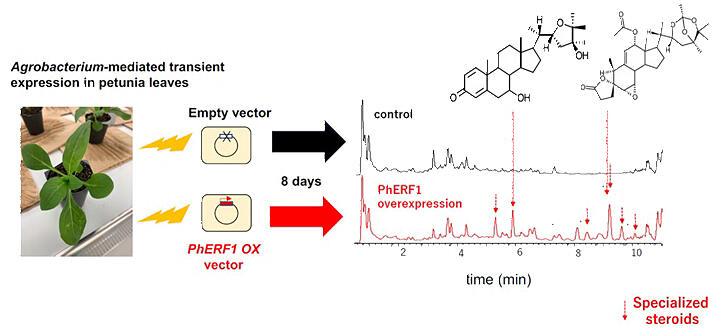The research group of Professor Tsubasa Shoji of the Institute of Natural Medicine at the University of Toyama, in collaboration with researchers from RIKEN and the University of Tsukuba, announced that they have successfully induced the production of plant steroid components within a short period of time using a single regulatory (transcription) factor. Petunia hybrida-derived ETHYLENE RESPONSE FACTOR 1 (PhERF1) is a regulatory factor that controls the functions of numerous synthetic enzyme genes in petunia leaves. By enhancing the activity of PhERF1, the research group succeeded in increasing the production of steroid components unique to the plant genus within a short time frame of eight days. They also confirmed the presence of steroid components that were hardly detectable before. Since related regulatory factors exist in most dicotyledonous plants, the observation will lead to the production and exploration of components unique to these plant species. The results were published in the October 31 issue of PNAS Nexus, a sibling journal of the Proceedings of the National Academy of Sciences.

Provided by the University of Toyama
Natural compounds with physiological activity have complex chemical structures, and their efficient artificial synthesis is often expensive and difficult to perform. Fermentation production using microorganisms also requires the identification and isolation of all synthetic enzyme genes, and successful reports on such attempts are few and far between. Shoji and his coworkers have previously reported that the nicotine in tobacco and the steroid glycoalkaloids (tomatine and solanine) with different structures are produced and accumulated under the control of regulatory factors that are structurally similar to each other. In the present study, the research group introduced the gene coding for PhERF1 (the petunia-related regulatory factor that has been reported in tomatoes and tobacco) into Agrobacterium and then infected petunia leaves with the gene-overexpressing bacterium, thereby enhancing the function of the transcription factor in the plant within a short time frame. They succeeded in increasing the production of various phytosteroid components in the infected plants.
Specifically, at four weeks after germination, the leaves of a potted petunia plant were infected by being sprayed with a solution containing the PhERF1-overexpressing Agrobacterium fungus to enhance the functionality of the transcription factor within a short time frame. The gene introduced with this method is expressed temporarily and is not inherited by the next generation. The research group confirmed that the amounts of various steroid components had increased in the plant at 8 days after infection.
Liquid chromatography-mass spectrometry analysis of an extract of the leaves on the 8th day after infection revealed many peaks of steroid components, including usually unobservable unknown compounds. Compared with the amount produced by regular plants, the increased production due to the transcription factor is estimated to be several tens to a hundred times higher.
Plants produce steroid components to protect themselves from bacteria and viruses. However, because the production has a trade-off relationship with plant growth, the content of steroids is usually low. Since the new method can substantially increase the production in mature plants, it is advantageous for producing and searching for components with potential medicinal effects.
Because regulatory factors similar to the one used in this study exist in most dicotyledonous plants, there is a high possibility that it can be applied to other plants as well. Furthermore, multiple other genes can be introduced with this method, and modification of the obtained components seems possible.
Shoji commented, "We only showed the example of petunia, but I think this can be widely applied to dicotyledonous plants. I believe that small molecular drugs previously produced in factories will now be able to be made in large quantities in a short period of time in fields or greenhouses. I also think we will be able to detect components we could not see previously. In drug research, a certain amount of the drug compound is necessary to examine its activity in animals, and a much larger amount is required for use as the actual medicine. I believe we can clear up these problems. I hope to draw the attention of various companies and researchers from many fields."
Journal Information
Publication: PNAS Nexus
Title: Induced production of specialized steroids by transcriptional reprogramming in Petunia hybrida
DOI: 10.1093/pnasnexus/pgad326
This article has been translated by JST with permission from The Science News Ltd. (https://sci-news.co.jp/). Unauthorized reproduction of the article and photographs is prohibited.




